工程力学英文版课件07 Stress for Axial Loads
工程力学全英文Engineering Mechanics (30)
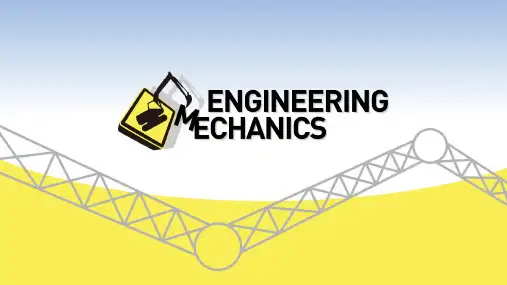
12
The Procedure of Analysis
to determine the relative displacement between two points A and B on axially loaded member 1. Internal Force
The method of sections; How to determine the location of the section?
Part II: Mechanics of Materials
Axial load
AXIAL LOAD
Average normal stress in axial loaded member
• The localization of the stress distribution
• The deformation of the axial loaded member • Analysis of indeterminate axial load member • Analysis of thermal stress and stress concentration • The stress on the inclined surface of an axial loaded member
If the force varies continuously along the member’s length, arbitrary location and P(x); If several constant external forces, each segment between any two external forces
AB 0
Since the end supports are fixed. Thus relative displacement of one end of the bar with respect to the other end to be equal to zero
Stress and Strain – Axial Loading
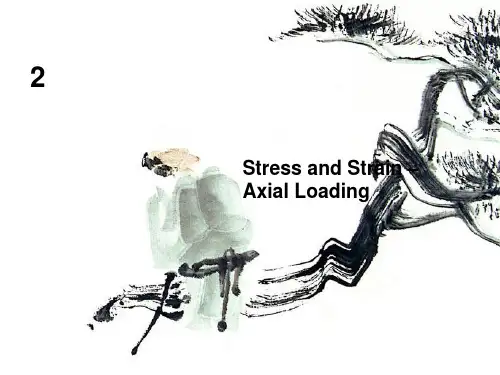
欢温
笑 暖 • Suitability of a structure or machine may depend on the deformations in
the structure as well as the stresses induced under loading. Statics
analyses alone are not sufficient.
SOLUTION: • Divide the rod into components at
the load application points.
• Apply a free-body analysis on each component to determine the internal force
at B and D.
GPa) and has a cross-sectional area of (600
mm2).
For the 30-kN force shown, determine the deflection a) of B, b) of D, and c) of E.
text, p. 63
said to behave elastically.
• The largest stress for which this occurs is called the elastic limit.
• When the strain does not return to zero after the stress is removed, the material is said to behave plastically.
2L L
却未 在与 枝群
头芳 Stress-Strain Test
机械类专业英语ppt课件
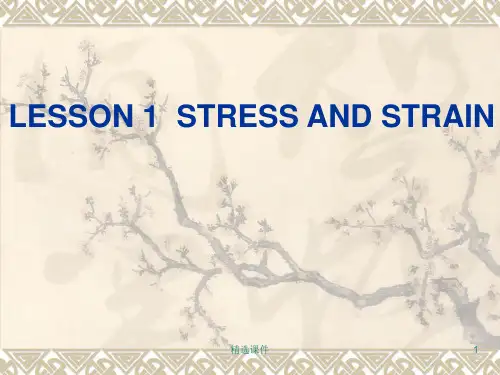
精选课件
14
❖ cumulative ['kjuːmjʊlətɪv]
❖ adj. 累积的
❖ cumulative error 累积误差 ; 积累误差 ; 累积差误 ❖ cumulative frequencies 累积频数 ; 累计频数 ❖ cumulative learning 累积学习
❖ dimensionless
精选课件
18
❖ uniaxial ❖ adj. 单轴(向)的,同轴的
念 ; 压力集中 ❖ axial stress 轴向应力 ; 轴应力 ; 多轴向应力 ❖ ; 热应力试验 ❖ stress corrosion 应力腐蚀 ; 超应力腐蚀 ; 应力腐化 ; 应 ❖ Stress ball 压力球 ; 减压球 ; 美国原装 ; 握力球 ❖ stress amplitude 应力幅 ; 应力幅值 ; 应力幅度 ; 应力振幅
精选课件
15
❖ quantity
❖ n. 参数,值;数量;总量
❖ physical quantity 物理量 ; 物理量 ; 实物量 ; 要的实物量 ❖ dimensionless quantity 无量纲量 ; 无因次量 ; 无因次值 ❖ average quantity 平均数量 ; 平均量 ; 均匀数量 ; 均匀数目 ❖ additional quantity 追加数量 ; 额外数量 ; 附加量 ❖ considerable quantity 大数量 ; 可观的
❖ magnitude
❖ n. 数量、数值;大小;量级
精选课件
10
❖ equilibrium ❖ n. 平衡;稳定;保持平衡的能力
❖ [,iːkwɪ'lɪbrɪəm]
工程力学英文版课件10 Shear Stresses and Strains,Torsion
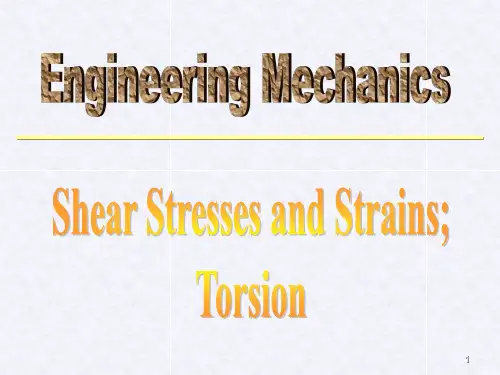
14
O1
dx
d
O2
E
C
G G H H
F
A
C B
D D
The angle , is indicated on the element. It can be related to the length dx of the element and the difference in the angle of rotation, d , between the shaded faces.
a
a’
d
d’
b
c
This angle is denoted by (gamma) and is measured in radians (rad).
7
Hooke’s Law for Shear The behaviour of a material subjected to pure shear can be studied in a laboratory by using specimens in the shape of thin circular tubes and subjecting them to a torsion loading. Experiments show that as for normal stress and strain, shear stress is proportional to shear strain as long as stress does not exceed the proportional limit. Hooke’s law for shear can be written as
工程力学全英文Engineering Mechanics (31)
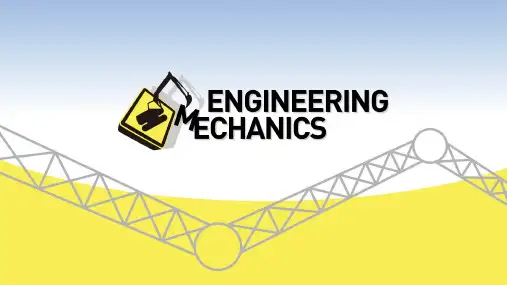
Part II:Mechanics of MaterialsTorsionStudy object: A long straight member subjected to a torsional loading •How to determine the stress distribution?•How to determine the angle of twist?•Statically indeterminate analysis of the member in torsion?Torsion:If a member is subjected to the action of a pair of moments which are of a common magnitude and opposite senses,and lie in planes perpendicular to the longitudinal axis,the member is said to be in torsion.Screwdriver bar Transmission shaftTorque: a moment that tends to twist a member about its longitudinal axis. Shaft: a member that deforms mainly in torsion.Assumptions :•The cross section remains a plane,and the size and shape remain the same (a rigid plane).•The cross section rotates about the longitudinal axis through an angle.The small element on the surface is under pure shear:By observation :Longitudinal lines : remain straight , twisted angle;the length of shaft remains unchangedRadial lines : remain straight and rotate about the center of the cross sectionCircumferential lines : remain the same and rotate about the longitudinal axis TORSIONAL DFORMATION OF A CIRCULAR SHAFT t M tMAngle of twist : the relative angular displacement between two cross-sections,()x φ The angle of twist varies linearly with x .()x φφ∆The angle of twist of the back face: ()x φThe angle of twist of the front face: ()x φφ+∆causes the element to be subjected to a shear strain.Isolate an element from the shaft After deformation Before deformationIf andx dx ∆→d φφ∆→Since and are the same for all points on the cross section at x dφdxThe shear strain within the shaft varies linearly along any radial line from zero to .max γρd constant dx φ=at a specific position x c cdx d ///max γργφ==max γργ⎪⎭⎫ ⎝⎛=cImportant points (review)☐Assumptions:for a shaft with a circular cross section subjected to a torque.•The cross-section remains a plane•The length of the shaft and its radius remain unchanged•Its radial lines remain straight and circles remain circular☐The shear strain varies linearly along any radial line.r If the material is linear-elastic, then Hooke’s law applies, G τγ=A linear variation in shear strain leads to a corresponding linear variation in shear stress . The integral depends only on the geometry of the shaft.2max max A T dA J c c ττρ==⎰Polar moment of inertia max ()()A A T dA dA c ρρτρτ==⎰⎰Each element of area located at ,is subjected to aforce of .The resultant internal torque producedby this force is dA ρ()dT dA ρτ=()dF dA τ=TORSIONAL FORMULAmax γργ⎪⎭⎫ ⎝⎛=c max τρτ⎪⎭⎫ ⎝⎛=cT J ρτ=wheremaxτT :c :J :Torsional formulaPolar moment of inertia()cc A cd d dA J 0403022)41(222ρπρρπρπρρρ⎰⎰⎰====42c J π=Note: J is a geometric property of the circular area and is always positive. The commonunit is mm 4Solid shaft Tubular shaft ()4402i c c J -=πO 2cρρd d 2d =A O 2c i 2c 0ρρdThe internal torque T develops a linear distribution of shear stress along each radial line in the plane of the cross-section,it also develops an associated shear-stress distribution along an axial plane.Why?T Jρτ=The internal torque T develops a linear distribution of shear stress along each radial line in the plane of the cross-section,it also develops an associated shear-stress distribution along an axial plane.Why?(complementary property of shear stress))(x TAbsolute Maximum Torsional Stress of a shaft -A torque diagramThis diagram is a plot of the internal torque T versus its position x along the shaft length. Sign convention: By right-hand rule, if the thumb directs outward from the shaft, then the internal torque is positive.The Procedure of Analysis to determine the shear stress for a shaft under torsion1. Internal Loading (Torque)Section the shaft perpendicular to its axis at the point where the shear stress is to be e free-body diagram and the equilibrium equations to obtain the internal torque.2. Cross Section Properties (Polar moment of inertia )3. Shear Stress Distribution (Torsional formula)T J ρτ=42c J π=()4402i c c J -=πJTc =max τThe shaft is supported by two bearings and is subjected to three torques. Determine the shear stress developed at point A and B , located at section a-a of the shaft.Example 1ABInternal Torque.The bearing force reactions on the shaft are zero, since the applied torques satisfy moment equilibrium about the shaft’s axis.The free body diagram of the left segment.mkN T T m kN m kN M x ⋅==-⋅-⋅=1250030004250 ;0∑ABmkN T ⋅=1250AB Cross Sectional Property. The polar moment of inertia for the shaft is 474 )10(97.4) 75(2mm mm J ==πShear Stress. Since point A is at ρ=c = 75 mm and point B at ρ= 15 mmGPa mm kN mm mm m kN J Tc A 89.1/89.1)10(97.4)75)(1250(247==⋅==τGPa mmmm m kN J T B 377.0)10(97.4)15)(1250(47=⋅==ρτAns.Important points (review)☐For a linear elastic homogenous material, the shear stress along any radial line of the shaft varies linearly from zero to a maximum value at the outer surface.☐The shear stress is also linearly distributed along an adjacent axial plane of the shaft due to the complementary property of shear stress.☐Torsional formula:valid for a shaft with circular cross-section and made of homogenous material with a linear-elastic behavior.Deformation of the shaftdxd γφρ=(linear elastic material)d dxρφγ=)(/)(x J x T ρτ=Gx J x T )(/)(ργ=γτG =dxGx J x T d )()(=φANGLE OF TWISTdxGx J xT d )()(=φIntegrating over the entire length L of the shaft,⎰=Ldx Gx J x T 0)()(φTORSIONJGTL =φ∑=JGTL φConstant Torque and Cross-Sectional Area⎰=L dx Gx J x T 0)()(φ⎰=Ldx E x A x P 0)()(δAEPL =δ(Axially loaded bar)TTT 2T 1T 3Sign ConventionRight-hand rule,the torque and angle will be positive,provided the thumb is directed outward from the shaftTo determine the angle of twist of one end of a shaft with respect to the other end:1. Internal Loading (Torque)•The method of section and the equation of moment equilibrium2. Angle of Twist•The polar moment of inertia J (x );•or •A consistent sign convention for the shaftGdx x J x T )(/)(⎰=φJG TL /=φ✓If the torque varies continuously along the shaft’s length, a section should be made at the arbitrary position, T (x )✓If several constant external torques exist, the internal torques in each segment between any two external torques much be determined (a torque diagram)The Procedure of AnalysisExample 2The two solid steel shafts shown are coupled together using the meshed gears. Determine the angle of twist of end A of the shaft AB when the torque T=45N·m is applied.G=80GPa.Shaft AB is free to rotate within bearing E and F,whereas shaft DC is fixed at D.Each shaft has a diameter of20mm.1. Internal Torque. F ree body diagrams of the shafts are shown in figures. Step 1:Solution300Nm 150.0m/45N m 150.0/,0m 150.00=⋅===⨯-→=∑T F F T MABx ()()mN 5.22m 075.0N 003m 075.0,0-m 075.00⋅=⨯=⨯==⨯=F T T F Mx D x D CDx ∑→2. Angle of Twist.To solve the problem, we need to calculate the rotation of gear C with respect to the fixed end D in shaft DC .rad 0269.0]N/m )10(80[)m 010.0)(2/()m 5.1)(m N 5.22(294/+=⋅+==πφJG TL DC DC Since the two gears are in mesh, of gear C causes gear B to rotate C φBφrad0134.0 )m 075.0)(rad 0269.0()m 15.0(=→=B B φφm 010.0=c GPa80=GThen we need to determine the angle of twist of end A with respect to end B of shaft AB .The rotation of end A is therefore determined by adding and since bothangles are in the same direction .B φB A /φrad0.0850 rad 0.0716rad 0134.0/+=+=+=B B A A φφφAns.m 010.0=c GPa 80=G rad0134.0 =B φHomework assignments: 5-3, 5-9, 5-27, 5-38,5-58, 5-71()()()()()[]rad 0716.0m/N 1080m 010.02/m 2m N 45294/=⋅+==πϕJG TL AB BAEquilibrium:;0=--=∑B A xT T T MThere are two unknowns, therefore this problem is indeterminate.Compatibility or the kinematic condition: two ends are fixed:/=B A φSTATICALLY INDETERMINATE TORQUE-LOADED MEMBERS=-JGL T JG L T BC B AC A ()BC ACL LL +=⎪⎭⎫⎝⎛=L L T T BC A ⎪⎭⎫ ⎝⎛=L L T T AC B TORSION;0∑==B A xT T T M-- ;0=/BA φThe Procedure of AnalysisTo determine the unknown torques in statically indeterminate shafts:•Equilibrium equationsDraw a free-body diagram of the shaft to identify all internal torques.Write the equations of moment equilibrium about the axis of the shaft.•CompatibilityExpress the compatibility condition in terms of the rotational displacements caused by the reactive torques.•Solving unknownsSolve the equilibrium and compatibility equations for the unknown reactive torques.Pay attention to the sign of the results.Example 3The shaft is made from a steel tube,which is bonded to a brass core.A torque of T=250N·m is applied at its end,plot the shear-stress distribution along a radial line of its cross-section.(G st=80GPa,G br=36GPa)Solution:Equilibrium. A free-body diagram of the shaft . The reaction has been represented by twounknown amount of torques resisted by the steel, T st and by the brass, T br .m N 250=⋅+--br st T T Compatibility. The angles of twist at fixed end A should be the same for both the steel and brass since they are bonded together .brst φφφ==Applying the load-displacement relationship , , we haveJG TL /=φbrbr br st st st J G LT J G L T =brst T T 33.33=(1)(2)m N 28.7m N 72.242⋅=⋅=⇒br st T TThe shear stress in the brass core varies from zero at its center to the maximum at the interface, using the torsional formulaMPa 63.4mm)/2)(10(mm)mm/m)(10 m)(10N 28.7()(43max =⋅==πτbr br br J c T For the steel, the minimum shear stress is at this interfaceMPa 30.10])mm 10(mm) /2)[(20(mm) mm/m)(10 m)(10N 72.242()(443min=-⋅==πτst inner st st J c T The maximum shear stress is at the outer surfaceMPa 630.20])mm 10(mm) /2)[(20(mm)mm/m)(20 m)(10N 72.242()(443max =-⋅==πτst outer st st J c Tm N 28.7mN 72.242⋅=⋅=br st T Trad )10(1286.0N/mm)10(36N/mm 63.43232-===G τγAns.Homework assignments: 5-75, 5-82, 5-85The shear stress is discontinuous at the interface because the materials have different moduli .The stiffer material (steel)carries more shear stress.However,the shear strain is continuous at the interface.Shear strain at the interface:MPa63.4)(max =br τMPa30.10)(min =st τMPa630.20)(max =st τ。
工程力学英文版课件04 Equilibrium of a Rigid Body
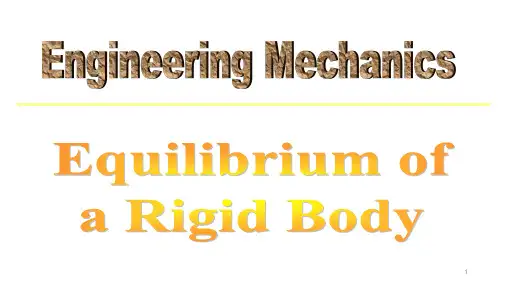
Equilibrium of a three-force body A body acted on by three forces is called a three-force body.
If a body is subjected to only three forces, then it is necessary that the forces be either concurrent or parallel for the body to be in equilibrium.
3
2. Construction of free-body diagrams Successful application of the equation of equilibrium requires a
complete specification of all the known and unknown external forces that act on the body. It is necessary to show all the forces and couple moments that the surroundings exert on the body so that these effects can be accounted for when the equations of equilibrium are applied. For this reason, a thorough understanding of how to draw a free-body diagram is of primary importance for solving problems in mechanics.
工程力学全英文Engineering Mechanics (34)
Part II:Mechanics of Materials Combined loadingsCOMBINED LOADINGSObjects of the section:•To analyze the stresses in thin-walled pressure vessels•To develop methods to analyze the stress in members subject to combined loadings(e.g. tension or compression, shear, torsion, bending moments).“Thin wall ”: A vessel having an inner-radius-to-wall-thickness ratio of 10 or more (r/t>= 10).The results of a thin-wall analysis will predict a stress that is approximately 4%less than the actual maximum stressIt is assumed that the stress distribution throughout the vessel’s thickness is uniform or constant.Cylindrical Vessels•A pressure p is developed within the vesselby a contained gas or fluid;•An element shown in the figure is assumedto be subjected to normal stress σ1in thecircumferential or hoop direction and σ2inthe longitudinal or axial direction.•Both stress exert tension on the materialPlane stressFor the hoop stress, the vessel is being sectioned by planes a, b and c.The uniform hoop stress σ1, acting throughout the vessel’s wall, the pressure acting the vertical face of the sectioned gas or fluid.10; 2[( )](2 )0x F t dy p r dy σ=-=∑1pr tσ=It can be imagined as the solidvertical face with p acting.For the axial stress, the vessel is being sectioned by the plane b .The uniform axial stress σ2, acting throughout the vessel’s wall, the pressure p acting the section of gas or fluid. It is assumed that the mean radius r is approximately equal to the vessel’s inner radius.220; (2)()0y Frt p r σππ=-=∑2pr σ=It can be imagined asthe solid section facewith p acting.1pr t σ=22pr tσ=σ1, σ2= the normal stress in the hoop and longitudinal directions, respectively. Each is assumed to be constant throughout the wall of the cylinder, and each subjects the material to tension .p = the internal pressure developed by the contained gas or fluidr = the inner radius of the cylindert = the thickness of the wall (r/t >=10)Spherical Vessels•A pressure p is developed within the vesselby a contained gas or fluid;•An element shown in the figure is assumedto be subjected to normal stress σ2, whichexerts tension on the material.the vessel is sectioned in half using section plane a. Equilibrium in y direction requires:220; (2)()0y F rt p r σππ=-=∑22pr t σ=It can be imagined asthe solid section facewith p acting.THIN-WALLED PRESSURE VESSELS☐Either a cylindrical or a spherical vessel is subjected to biaxial stress.☐The material of the vessel is also subjected to a radial stress σ3, which acts along a radial line. The maximum of it equals to p at the interior wall and decreases to zero at the exterior wall.☐The radial stress σ3will be ignored because σ1and σ2are 5 to 10 times higher than σ3.☐External pressure might cause the vessel to buckle.A member is subjected either an internal axial force, a shear force, a bending moment, or a torsional moment.Several these types of loadings are applied to the member simultaneouslyPrinciple of SuperpositionResultant stress distribution caused by the loads.•A linear relationship exists between the stress and the loads •The geometry of the member should not undergo significant changeAssumptions STATE OF STRESS CAUSED BY COMBINED LOADINGSThe Procedure of Analysisto determine the resultant stress distribution caused by combined loadingsInternal Loadings•Section the member perpendicular to its axis at the point where the stress to be determined and obtain N,M,V and T.•The force components should act through the centroid of the cross section and the moment components should be computed about the centroidal axes .Average Stress Components•Compute the stress component associated with each internal loading.(Distribution of stress acting over the entire cross-sectional area or the stress at a specific point)How?(The neutral axis)NORMAL FORCE P SHEAR FORCE V BENDING MOMENT TORSIONAL MOMENT or THIN-WALLED PRESSURE VESSELS: and SuperpositionOnce the normal and shear stress components for each loadings have beencalculated, use the principle of superposition and determine the resultant normal and shear stress components.x P Aσ=VQ Itτ=y z x z yM z M y I I σ=-+T Jρτ=2m T A t τ=1pr tσ=22pr t σ=Important points (review)☐Pressure vessels: For a thin wall cylindrical pressure vessel with r/t >= 10; the hoop stress is σ1= pr/t. The longitudinal stress is σ2= pr/2t.☐For a thin wall spherical vessels having the same normal tensile stress, which is σ= σ2 = pr/2t.1☐Superposition of stress components: The procedure to analyze the stress state ofa point for a member, which is subjected to a combined loading.Homework assignments: 8-5, 8-15, 8-21, 8-41, 8-54Example 1A force of 15000 N is applied to the edge of the member shown below. Neglect the weight of the member and determine the state of stress at pointsB and C.Solution:1. Internal Loadings. It is sectioned through B and C. For equilibrium at the section, the internal loadings is shown below.2. Stress Components.Normal Force: 150003.75MPa (100)(40)P A σ===Bending moment: The normal force distribution due to bending moment is shown below. 33(40)(100)1212bh I ==N A315000(50)11.25MPa (112)(40)(100)B B My I σ-=-=-=315000(50)11.25MPa (112)(40)(100)c c My I σ=-=-=-yz3. Superposition 3()15000(50)( 3.75)7.5 MPa (112)(40)(100)B B My P I A σ--=-+=-+-=(tension)3()15000(50)( 3.75)15 MPa (112)(40)(100)c c My P I A σ-=-+=-+-=-(compression)Example 2The member shown has a rectangular cross section. Determine the state of stress that the loading produces at point C.Solution:AB F Ax = 16.45 kN; F Ay = 21.93 kN; F B = 97.59 kN1. Internal Loadings. The support reactions on the member have been determined and shown. (Using the equations of equilibrium for the whole member)After the support reactions have known,the internalloadings at section C have been determined and shownin the right figure.2. Stress Components.Normal Force: Shear Force: C C C C It y A V It VQ ''==τSince A= 0, thus Q C = 0, τC = 0 MPa 32.1)250.0)(050.0(45.16===A N C σBending moment: Point C is located aty = c = 125 mm from the neutral axis,so the normal stress at C.MPa 15.63)250.0)(050.0(121)125.0)(89.32(3=⎥⎦⎤⎢⎣⎡==I Mc C σσC =63.15 MPa3. SuperpositionMPa 5.6415.6332.1=+=C σAns.。
工程力学全英文Engineering Mechanics (32)
How to determine the position of the section (method of
section)?
Shear (V) and bending moment (M) must be determined for each region of the beam located between any two discontinuities of loadings
If the internal moment (M) causes compression in the top fibers, then it is considered to be positive.
10 10
The Procedure of Analysis
to draw the shear and moment diagrams of a beam
Example:
A simply supported beam
A cantilever beam
An overhanging beam
4 4
Beams in Aerospace Engineering?
5
5
BENDING
Objective of the chapter: determine the stress distribution in beams and shafts under bending Assumptions: • A straight beam or shaft with a symmetric cross section • Homogenous and linear elastic material
Part II: Mechanics of Materials Bending
工程力学专业外语60页PPT
Elastic Range: • Linear elastic: • Nonlinear elastic:
Plastic Range: • Yield point
• Yield strength • Ultimate strength
力学 mechanics 牛顿力学 Newtonian mechanics 经典力学 classical mechanics 静力学 statics 运动学 kinematics 动力学 dynamics 动理学 kinetics 宏观力学 macroscopic mechanics, macromechanics 细观力学 mesomechanics 微观力学 microscopic mechanics, micromechanics 一般力学 general mechanics 固体力学 solid mechanics 流体力学 fluid mechanics 理论力学 theoretical mechanics 应用力学 applied mechanics 工程力学 engineering mechanics 实验力学 experimental mechanics 计算力学 computational mechanics 理性力学 rational mechanics 物理力学 physical mechanics 地球动力学 geodynamics 分析力学 analytical mechanics
1. Stress and strain are related terms used to define the intensity of internal reactive forces in a deformed body and associated unit change of dimension, shape, or volume by externally applied forces.
工程力学专业英语翻译PPT课件
Note that E has the same units as stress. The modulus of elasticity is sometimes called Young’s modulus, after the English scientist Thomas Young (1773-1829) who studied the elastic behavior of bars. For most materials the modulus of elasticity in compression is the same as in tension.
Eq.(1) can be regarded as the equation for the uniform stress in a prismatic bar. This equation shown that stress has units of force divided by area. When the bar is being stretched by the force P , as shown in the figure, the resulting stress is a tensile stress; if the forces are reversed in direction, causing the bar to be compressed, they are called compressive stress.
- 1、下载文档前请自行甄别文档内容的完整性,平台不提供额外的编辑、内容补充、找答案等附加服务。
- 2、"仅部分预览"的文档,不可在线预览部分如存在完整性等问题,可反馈申请退款(可完整预览的文档不适用该条件!)。
- 3、如文档侵犯您的权益,请联系客服反馈,我们会尽快为您处理(人工客服工作时间:9:00-18:30)。
F1
F2
F3
Fn
10
Axial force FN, Shear force FQ,
Bending moment MB,
Torque or twisting moment MX
FQ
FR
Mx
FN
MB
M
11
Procedure for the method of section
Calculation of the internal forces is foundation to analyze the problems of strength, rigidity, stability etc. General method to determine internal forces is the method of section. The following steps should be performed:
8
A section was used to cut the member into two parts.
F1Biblioteka F2F3Fn
9
The internal forces of the member cut became the external forces, and can be found by the equilibrium equations.
1
Internal Reactions: Stress for Axial Loads
§10–1 Introduction §10–2 Problems Involving Normal,
Shear and Bearing Stress §10–3 Allowable Stress §10–4 Stresses on Oblique Sections
13
Internal forces in an axially loaded member
P
P
P
P
Sign Convention. When the internal force acting outwards from the section (‘pulls’) is termed tensile force and given a positive sign. Force acting towards the section (‘pushes’) is termed compressive force and is negative in sign.
In order to find internal forces in members of a system, the member was cut with a section. Then a free-body diagram of either part of this member was constructed. The forces in the members cut became external forces and were found by the equilibrium equations.
Equilibrium. Set up equilibrium equations for the remained part and determine the unknown internal forces according to the external forces acted it.(Here the internal forces in the cutoff section are the external forces for the remained part)
Cut off. Assume to separate the member into two distinct parts in the section in which the internal forces want to be determined.
12
Substitute. Take arbitrary part and substitute the action of another part to it by the corresponding internal force in the cut-off section.
4
This subject also involves computing the deformations of the body when the body is subjected to external forces.
5
And it provides a study of the body’s stability when the body is subjected to external forces.
2
§10-1 Introduction
3
Mechanics of materials is a branch of mechanics that studies the relationships between the external loads applied to a deformable body and the intensity of internal forces acting within the body.
6
Strength:
Capacity of a component or a structural element to resist failure.
Rigidity (Stiffness):
Capacity of a component or a structural element to resist deformation.
Stability:
Capacity of a component or a structural element to retain the original state of equilibrium.
7
1. Internal Reactions
Forces created within objects that are acted upon by external loads, including axial force, shear force, bending moment, and torque or twisting moment.
